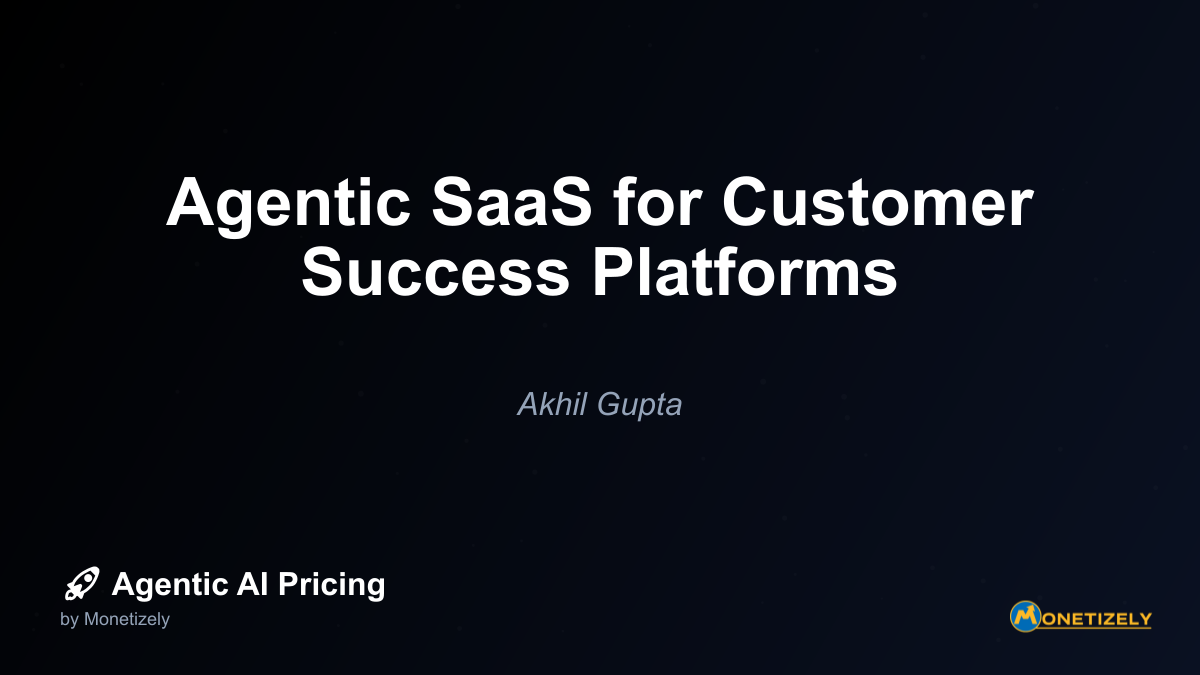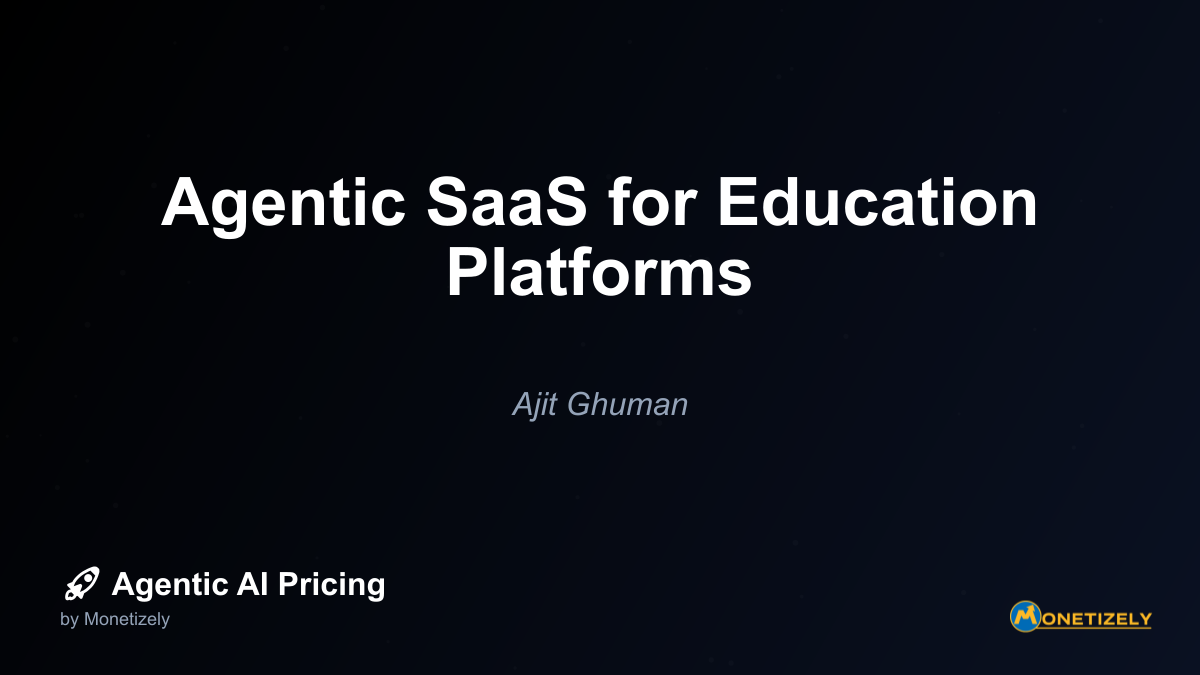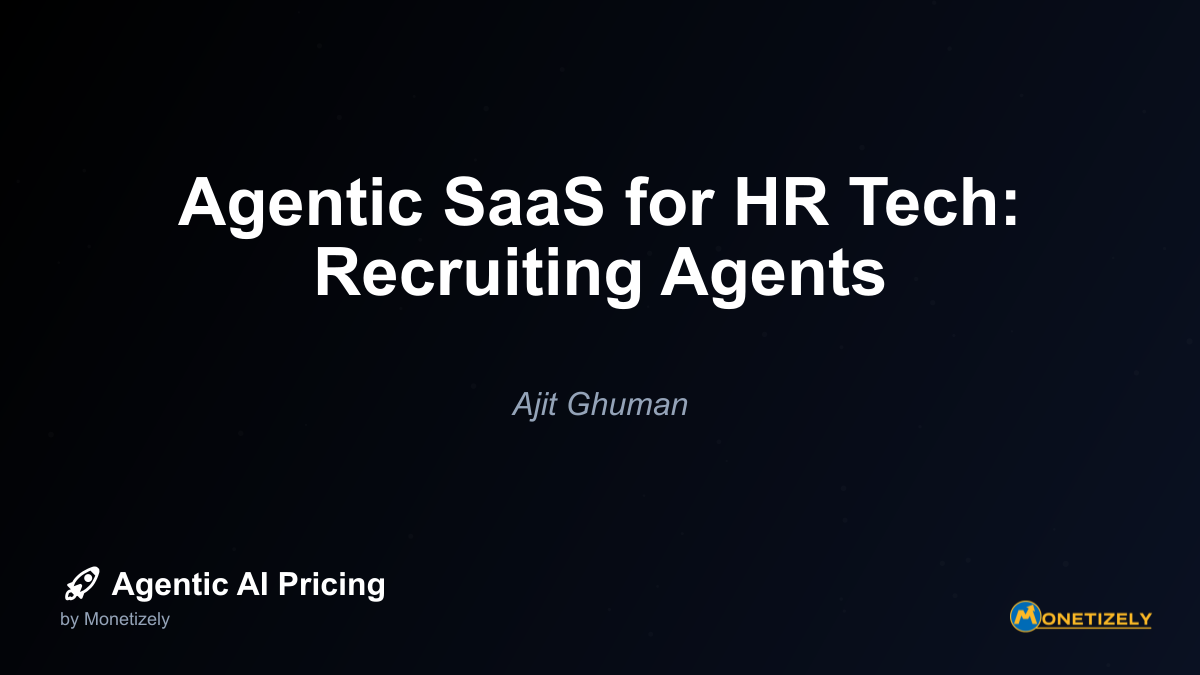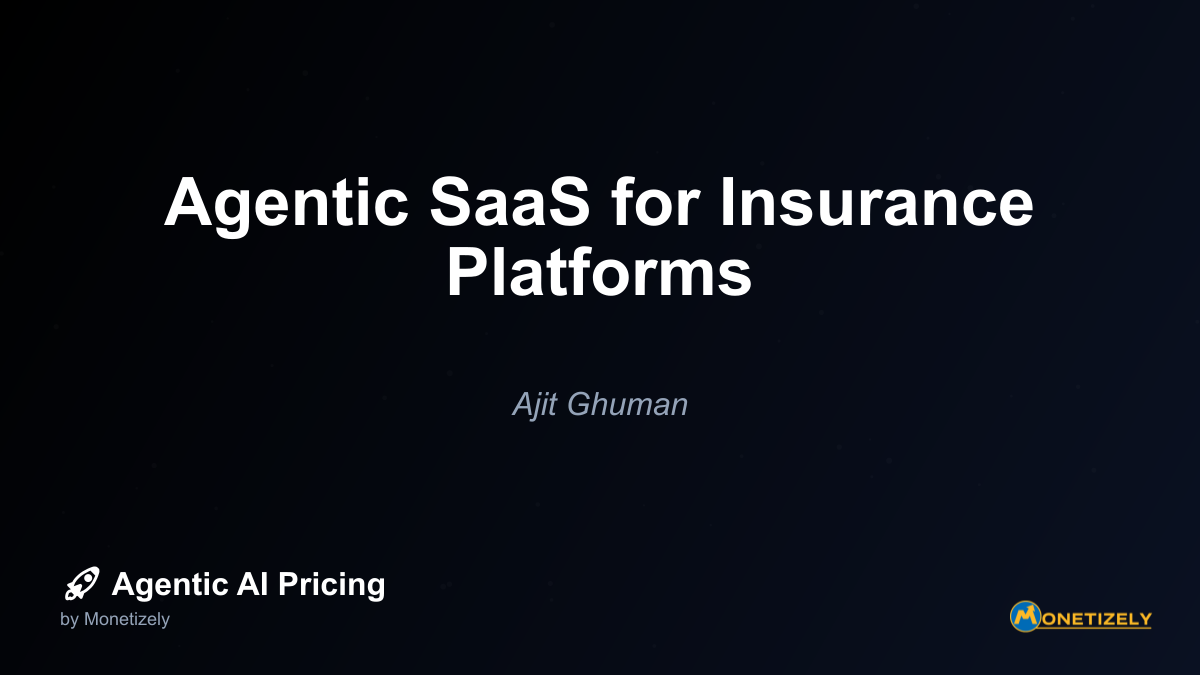· Ajit Ghuman · Vertical Applications · 11 min read
Agentic SaaS in Fintech: Compliance Agents at Scale
AI and SaaS Pricing Masterclass
Learn the art of strategic pricing directly from industry experts. Our comprehensive course provides frameworks and methodologies for optimizing your pricing strategy in the evolving AI landscape. Earn a professional certification that can be imported directly to your LinkedIn profile.

In today’s rapidly evolving financial landscape, regulatory compliance has become increasingly complex and resource-intensive. Financial institutions face mounting pressure to stay compliant with ever-changing regulations while optimizing operational efficiency. Enter agentic AI—autonomous, goal-oriented artificial intelligence systems that can revolutionize how fintech companies approach compliance challenges. This transformative technology is reshaping the compliance function from a cost center into a strategic advantage through automation, continuous monitoring, and intelligent decision support.
The Evolution of Compliance in Fintech: From Manual Processes to Agentic Systems
Traditional compliance workflows in financial services have historically been labor-intensive, requiring teams of specialists to manually review transactions, verify customer identities, and ensure adherence to regulatory requirements. This approach is not only expensive but also prone to human error and inconsistency. According to recent industry surveys, financial institutions spend approximately 10-15% of their operational budgets on compliance activities, with larger banks allocating billions annually to regulatory compliance.
The journey from manual processes to agentic systems has unfolded in distinct phases:
First Wave: Rule-Based Automation
Early compliance automation relied on simple rule-based systems that could flag specific patterns or transactions based on predefined criteria. While this represented an improvement over purely manual processes, these systems lacked flexibility and intelligence, generating high volumes of false positives and requiring significant human oversight.
Second Wave: Machine Learning Models
The introduction of machine learning brought more sophisticated pattern recognition capabilities to compliance functions. These systems could analyze historical data to identify anomalies and potential compliance issues with greater accuracy than rule-based approaches. However, they typically operated within narrow domains and required substantial human intervention for decision-making.
Third Wave: Agentic AI Compliance Systems
Agentic AI represents the next evolutionary leap in compliance technology. These systems combine advanced machine learning with autonomous decision-making capabilities, allowing them to:
- Monitor compliance continuously across multiple regulatory frameworks
- Adapt to changing regulations without extensive reprogramming
- Take independent actions within defined parameters
- Learn from interactions and improve over time
- Coordinate with other systems and human team members
As Max Braglia, developer of the first SEC and FINRA-compliant multi-agent system, explains: “The breakthrough with agentic AI is embedding compliance review directly into autonomous agents’ workflows, allowing real-time self-monitoring and validation against regulations.”
Market Trends: Rapid Adoption of Agentic AI in Fintech Compliance
The fintech compliance landscape is experiencing unprecedented transformation through agentic AI adoption. Recent market data reveals the scale and pace of this change:
Adoption Rates and Market Growth
According to industry surveys, approximately 93% of financial institutions plan to implement agentic AI within the next two years, with 6% having already integrated these technologies into their compliance workflows. This rapid adoption is driving explosive market growth, with the agentic AI market for financial services projected to expand from $2.1 billion in 2024 to $80.9 billion by 2034, representing a compound annual growth rate (CAGR) of 43.8%.
Priority Use Cases in Compliance
Financial institutions are strategically deploying agentic AI across various compliance functions, with particular emphasis on:
- Fraud Detection (36%): Leveraging pattern recognition to identify suspicious activities in real-time
- KYC Maintenance (19%): Automating customer identity verification and ongoing monitoring
- Transaction Monitoring (16%): Continuously screening transactions for regulatory compliance
- Regulatory Reporting (12%): Streamlining the preparation and submission of required reports
- Policy Management (9%): Keeping internal policies aligned with evolving regulations
Cost Impact and Operational Efficiencies
The financial impact of agentic AI on compliance operations is substantial. Over 25% of financial institutions implementing these technologies expect to save more than $4 million annually in compliance operations. These savings stem from multiple sources:
- Reduced Manual Processing: Agentic AI systems can handle up to 90% of routine compliance tasks without human intervention
- Lower False Positives: Advanced pattern recognition reduces false alerts by 39% compared to traditional models
- Faster Processing Times: Compliance checks that previously took days can be completed in minutes or seconds
- Decreased Compliance Failures: Continuous monitoring reduces the risk of overlooking regulatory issues
How Agentic AI Transforms Fintech Compliance Functions
Agentic AI is revolutionizing specific compliance functions through its unique capabilities for autonomous operation, continuous learning, and intelligent decision-making.
Anti-Money Laundering (AML) Compliance
Traditional AML processes rely on rule-based transaction monitoring systems that generate high volumes of alerts requiring manual review. Agentic AI transforms this approach by:
- Contextual Analysis: Understanding the broader context of transactions beyond simple rules
- Behavioral Modeling: Creating dynamic customer profiles that adapt to changing patterns
- Autonomous Investigation: Conducting preliminary investigations without human intervention
- Continuous Learning: Improving detection accuracy over time through feedback loops
- Multi-data Integration: Incorporating external data sources for enhanced risk assessment
A major European bank implemented an agentic AI system for AML compliance in 2024, reducing false positives by 42% while increasing suspicious activity detection by 27%. The system autonomously investigates alerts, prepares documentation, and only escalates cases requiring human judgment.
Know Your Customer (KYC) Processes
KYC procedures traditionally involve extensive document collection, verification, and periodic reviews. Agentic AI streamlines these processes through:
- Automated Document Processing: Extracting and verifying information from identity documents
- Continuous Customer Monitoring: Proactively identifying changes in customer risk profiles
- Dynamic Risk Assessment: Adjusting due diligence requirements based on real-time risk factors
- Cross-jurisdictional Compliance: Managing varying KYC requirements across different regions
- Seamless Customer Experience: Reducing friction while maintaining regulatory compliance
Bud Financial, a UK fintech firm, deployed agentic KYC agents that reduced onboarding time from days to minutes while improving compliance accuracy. The system continuously monitors customer information against global watchlists and regulatory changes, automatically initiating additional verification when risk factors change.
Regulatory Reporting
Financial institutions must regularly prepare and submit numerous regulatory reports, a process that traditionally consumes significant resources. Agentic AI enhances regulatory reporting through:
- Automated Data Collection: Gathering information from disparate systems without manual intervention
- Format Conversion: Adapting data to meet specific regulatory requirements
- Quality Assurance: Validating report accuracy before submission
- Regulatory Change Monitoring: Updating reporting templates based on new requirements
- Cross-functional Coordination: Orchestrating inputs from various departments
A global investment bank implemented agentic reporting agents that reduced regulatory reporting preparation time by 70% while improving accuracy. The system proactively monitors regulatory changes and automatically adjusts reporting templates, ensuring compliance with evolving requirements.
Case Studies: Real-World Implementations of Agentic Compliance Agents
Case Study 1: JPMorgan Chase’s Embedded Compliance Agents
JPMorgan Chase implemented agentic AI to enhance customer service while maintaining strict regulatory compliance. The system features embedded compliance agents that:
- Monitor customer interactions in real-time for compliance issues
- Provide contextual guidance to customer service representatives
- Document compliance-relevant information automatically
- Adapt to changing regulatory requirements without system overhauls
Results:
- 35% reduction in compliance-related escalations
- 42% improvement in customer satisfaction scores
- $12 million annual savings in compliance operations
- 98.7% accuracy in regulatory adherence
Case Study 2: Multi-Agent Compliance System with SEC/FINRA Validation
A pioneering implementation developed by Max Braglia uses the Agno framework to create a multi-agent system specifically designed for SEC and FINRA compliance in financial services. This system features:
- Specialized autonomous agents with distinct roles and expertise
- A dedicated compliance reviewer agent trained on regulatory requirements
- Real-time validation of actions against compliance frameworks
- Self-monitoring capabilities that prevent potential violations
Applications include:
- Content creation oversight
- Automated trading systems
- Customer communication monitoring
- Regulatory reporting
This represents a breakthrough in embedding compliance directly into agentic systems rather than applying it as an afterthought.
Case Study 3: Bud Financial’s Autonomous Money Management
Bud Financial implemented agentic AI that proactively manages client finances while maintaining strict compliance with financial regulations. The system:
- Transfers funds automatically to prevent overdrafts
- Optimizes interest rates without user prompts
- Ensures all actions comply with relevant regulations
- Provides transparent explanations of all automated decisions
This implementation demonstrates how agentic AI can simultaneously enhance customer experience and strengthen compliance, creating a competitive advantage in the marketplace.
Technical Architecture: Building Effective Agentic Compliance Systems
Creating effective agentic compliance systems requires carefully designed technical architecture that balances autonomy with control, scalability with security, and innovation with regulatory adherence.
Core Components of Agentic Compliance Systems
Perception Layer: Collects and processes data from multiple sources, including:
- Transaction systems
- Customer databases
- Regulatory updates
- Market information
- External watchlists and sanctions databases
Reasoning Engine: Analyzes information and makes decisions using:
- Machine learning models
- Natural language processing
- Knowledge graphs
- Causal reasoning
- Reinforcement learning
Action Framework: Executes decisions through:
- API integrations with core banking systems
- Workflow automation tools
- Communication channels
- Documentation systems
- Human escalation protocols
Learning Module: Improves performance over time through:
- Feedback loops
- Performance metrics
- Model retraining
- Anomaly detection
- Behavior analysis
Governance Layer: Ensures appropriate oversight through:
- Audit trails
- Explainability tools
- Human review mechanisms
- Compliance guardrails
- Performance monitoring
Integration with Legacy Systems
Financial institutions typically operate complex technology ecosystems with numerous legacy systems. Successful agentic AI implementation requires thoughtful integration approaches:
- API-First Strategy: Developing standardized interfaces for system interaction
- Microservices Architecture: Creating modular components that can be deployed incrementally
- Data Orchestration: Establishing unified data access across disparate systems
- Hybrid Cloud Deployment: Balancing on-premises requirements with cloud scalability
- Progressive Implementation: Starting with specific use cases and expanding gradually
According to integration specialists at Arion Research, “Making agents work with legacy systems requires careful planning to bridge incompatibilities and prevent system failures. This often involves expensive custom development and comprehensive dependency assessments before deployment.”
Compliance by Design
Rather than treating compliance as an add-on feature, effective agentic systems incorporate regulatory requirements directly into their architecture:
- Regulatory Knowledge Base: Maintaining comprehensive, up-to-date regulatory information
- Compliance Checkpoints: Embedding validation at key decision points
- Explainable AI: Ensuring decisions can be understood and justified
- Audit Trails: Recording all actions and decision factors
- Override Mechanisms: Allowing human intervention when necessary
This “compliance by design” approach ensures that agentic systems operate within regulatory boundaries while maintaining operational efficiency.
Implementation Challenges and Solutions
Despite their transformative potential, implementing agentic AI for fintech compliance presents significant challenges. Understanding these obstacles and their solutions is crucial for successful deployment.
Technical Challenges
Integration Complexity
- Challenge: Legacy systems with technical debt create integration barriers
- Solution: Develop abstraction layers and middleware to facilitate communication between agentic AI and existing systems
Data Quality and Accessibility
- Challenge: Compliance functions require high-quality data from multiple sources
- Solution: Implement data governance frameworks and create unified data access layers
Performance and Scalability
- Challenge: Agentic systems must process large volumes of transactions in real-time
- Solution: Adopt cloud-native architectures and implement efficient processing algorithms
Security and Privacy
- Challenge: Compliance data often contains sensitive customer information
- Solution: Implement robust encryption, access controls, and data minimization practices
Regulatory Challenges
Explainability Requirements
- Challenge: Regulators require transparency in AI decision-making
- Solution: Implement explainable AI techniques and comprehensive documentation
Regulatory Variations
- Challenge: Compliance requirements differ across jurisdictions
- Solution: Design adaptable systems with jurisdiction-specific rule engines
Liability Concerns
- Challenge: Unclear responsibility for automated compliance decisions
- Solution: Establish clear governance frameworks and human oversight mechanisms
Regulatory Acceptance
- Challenge: Gaining regulator approval for innovative compliance approaches
- Solution: Engage proactively with regulators and demonstrate system effectiveness
Organizational Challenges
Skill Gaps
- Challenge: Limited expertise in both compliance and AI technologies
- Solution: Invest in training programs and cross-functional teams
Change Management
- Challenge: Resistance to automation of traditional compliance roles
- Solution: Focus on augmentation rather than replacement and demonstrate value
Cost Justification
- Challenge: Difficulty quantifying ROI for compliance investments
- Solution: Develop comprehensive metrics that capture both direct and indirect benefits
Governance Structures
- Challenge: Unclear responsibility for agentic AI systems
- Solution: Establish dedicated governance committees with clear accountability
Pricing Models for Agentic Compliance Solutions
The unique characteristics of agentic AI require innovative pricing approaches that align costs with value creation. Several pricing models have emerged in the market:
Usage-Based Pricing
Usage-based pricing models charge based on the actual utilization of agentic compliance systems, measured through metrics such as:
- Transaction Volume: Fees based on the number of transactions monitored
- Alert Processing: Charges for each alert investigated
- API Calls: Pricing tied to system interactions
- Compute Resources: Costs based on processing power utilized
This approach aligns costs directly with system usage, making it attractive for organizations with variable compliance workloads.
Outcome-Based Pricing
Outcome-based models tie pricing to measurable business results, such as:
- Compliance Improvement: Fees based on reduced regulatory violations
- Cost Savings: Pricing linked to demonstrable operational savings
- Risk Reduction: Charges aligned with lower compliance risk profiles
- Processing Efficiency: Costs tied to improvements in processing times
This approach creates shared incentives between vendors and clients but requires clear measurement methodologies.
Value-Based and Risk-Adjusted Pricing
Value-based pricing models consider the strategic impact of agentic compliance systems:
- Risk-Adjusted Pricing: Fees based on the complexity of compliance requirements
- Value Differentiation: Pricing tiers aligned with feature sophistication
- Industry-Specific Pricing: Costs adjusted for regulatory complexity in different sectors
- Enterprise Value Alignment: Pricing scaled to organizational impact
As noted in recent Monetizely research, “Risk-adjusted pricing enables financial institutions to accurately price products or fees based on individual risk profiles, creating more equitable and profitable customer relationships.”
Hybrid Models
Many organizations implement hybrid pricing approaches that combine elements of multiple models:
- Base subscription with usage components
- Tiered pricing with outcome incentives
- Foundational services with premium add-ons
- Shared risk/reward structures
These hybrid models provide flexibility while ensuring alignment between costs and benefits.
ROI Calculation for Agentic Compliance Investments
Evaluating the return on investment for agentic compliance systems requires comprehensive analysis across multiple dimensions:
Direct Cost Savings
- Personnel Efficiency: Reduction in compliance staff hours or reallocation to higher-value activities
- Process Automation: Elimination of manual tasks and associated costs
- Error Reduction: Fewer costly compliance mistakes requiring remediation
- Technology Consolidation: Replacement of multiple point solutions with integrated platforms
Risk Mitigation Benefits
- Reduced Regulatory Fines: Lower incidence of compliance violations and associated penalties
- Decreased Legal Expenses: Fewer regulatory actions requiring legal defense
- Reputational Protection: Avoidance of negative publicity from compliance failures
- Lower Insurance Costs: Reduced premiums due to improved risk profiles
Strategic Advantages
- Market Expansion: Ability to enter new markets with complex regulatory requirements
- Product Innovation: Faster deployment of compliant financial products
- Customer Experience: Improved onboarding and service with embedded compliance
- Competitive Differentiation: Compliance excellence as a market advantage
ROI Calculation Framework
A comprehensive ROI framework for agentic compliance investments includes:
Cost Components:
- Implementation costs (software, integration, training)
- Ongoing operational expenses
- Maintenance and updates
- Governance and oversight
Benefit Components:
- Direct cost reductions
- Risk mitigation value
- Strategic opportunity creation
- Productivity improvements
Time Horizon:
- Short-term operational impacts
- Medium-term risk reduction
- Long-term strategic advantages
Industry data suggests that organizations implementing agentic AI for compliance can achieve ROI of 100-200% within 12-24 months, with some U.S. companies reporting average returns close to 192%.
Regulatory Outlook and Compliance Considerations
The regulatory landscape for agentic AI in financial services continues to evolve, with implications for compliance strategies and implementation
Co-Founder & CEO
Ajit is the author of Price To Scale, a top book on SaaS Pricing and is the Founder of Monetizely. Ajit has led and worked in pricing and product marketing at firms like Twilio, Narvar and Medallia. His work has been featured in Forbes and VentureBeat. Ajit regularly consults with software companies from Seed stage to post-IPO on pricing strategy. Ajit is also a highly-rated co-instructor for 'The Art of SaaS Pricing and Monetization' on Maven.
Pricing Strategy Audit
Let our experts analyze your current pricing strategy and identify opportunities for improvement. Our data-driven assessment will help you unlock untapped revenue potential and optimize your AI pricing approach.




